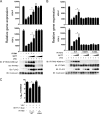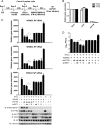Negative regulation of interferon-induced transmembrane protein 3 by SET7-mediated lysine monomethylation
- PMID: 24129573
- PMCID: PMC3853261
- DOI: 10.1074/jbc.M113.511949
Negative regulation of interferon-induced transmembrane protein 3 by SET7-mediated lysine monomethylation
Abstract
Although lysine methylation is classically known to regulate histone function, its role in modulating antiviral restriction factor activity remains uncharacterized. Interferon-induced transmembrane protein 3 (IFITM3) was found monomethylated on its lysine 88 residue (IFITM3-K88me1) to reduce its antiviral activity, mediated by the lysine methyltransferase SET7. Vesicular stomatitis virus and influenza A virus infection increased IFITM3-K88me1 levels by promoting the interaction between IFITM3 and SET7, suggesting that this pathway could be hijacked to support infection; conversely, IFN-α reduced IFITM3-K88me1 levels. These findings may have important implications in the design of therapeutics targeting protein methylation against infectious diseases.
Keywords: Antiviral Agents; Antiviral Host Restriction Factors; Host Defense; Host-pathogen Interactions; IFITM3; Lysine Methylation; Post-translational Modification; Protein Methylation; SET7.
Figures






Similar articles
-
Duck Interferon-Inducible Transmembrane Protein 3 Mediates Restriction of Influenza Viruses.J Virol. 2015 Oct 14;90(1):103-16. doi: 10.1128/JVI.01593-15. Print 2016 Jan 1. J Virol. 2015. PMID: 26468537 Free PMC article.
-
Histone demethylase LSD1 restricts influenza A virus infection by erasing IFITM3-K88 monomethylation.PLoS Pathog. 2017 Dec 27;13(12):e1006773. doi: 10.1371/journal.ppat.1006773. eCollection 2017 Dec. PLoS Pathog. 2017. PMID: 29281729 Free PMC article.
-
The Host Restriction Factor Interferon-Inducible Transmembrane Protein 3 Inhibits Vaccinia Virus Infection.Front Immunol. 2018 Feb 16;9:228. doi: 10.3389/fimmu.2018.00228. eCollection 2018. Front Immunol. 2018. PMID: 29503647 Free PMC article.
-
Regulation of the trafficking and antiviral activity of IFITM3 by post-translational modifications.Future Microbiol. 2014;9(10):1151-63. doi: 10.2217/fmb.14.65. Future Microbiol. 2014. PMID: 25405885 Free PMC article. Review.
-
Positive Regulation of the Antiviral Activity of Interferon-Induced Transmembrane Protein 3 by S-Palmitoylation.Front Immunol. 2022 Jun 13;13:919477. doi: 10.3389/fimmu.2022.919477. eCollection 2022. Front Immunol. 2022. PMID: 35769480 Free PMC article. Review.
Cited by
-
The Antiviral Activity of Interferon-Induced Transmembrane Proteins and Virus Evasion Strategies.Viruses. 2024 May 6;16(5):734. doi: 10.3390/v16050734. Viruses. 2024. PMID: 38793616 Free PMC article. Review.
-
Bat and pig IFN-induced transmembrane protein 3 restrict cell entry by influenza virus and lyssaviruses.J Gen Virol. 2015 May;96(Pt 5):991-1005. doi: 10.1099/vir.0.000058. Epub 2015 Jan 22. J Gen Virol. 2015. PMID: 25614588 Free PMC article.
-
Anti-H7N9 avian influenza A virus activity of interferon in pseudostratified human airway epithelium cell cultures.Virol J. 2019 Apr 3;16(1):44. doi: 10.1186/s12985-019-1146-4. Virol J. 2019. PMID: 30944006 Free PMC article.
-
Duck Interferon-Inducible Transmembrane Protein 3 Mediates Restriction of Influenza Viruses.J Virol. 2015 Oct 14;90(1):103-16. doi: 10.1128/JVI.01593-15. Print 2016 Jan 1. J Virol. 2015. PMID: 26468537 Free PMC article.
-
Host Methyltransferases and Demethylases: Potential New Epigenetic Targets for HIV Cure Strategies and Beyond.AIDS Res Hum Retroviruses. 2017 Nov;33(S1):S8-S22. doi: 10.1089/aid.2017.0180. AIDS Res Hum Retroviruses. 2017. PMID: 29140109 Free PMC article. Review.
References
-
- Lewin A. R., Reid L. E., McMahon M., Stark G. R., Kerr I. M. (1991) Molecular analysis of a human interferon-inducible gene family. Eur. J. Biochem. 199, 417–423 - PubMed
-
- Everitt A. R., Clare S., Pertel T., John S. P., Wash R. S., Smith S. E., Chin C. R., Feeley E. M., Sims J. S., Adams D. J., Wise H. M., Kane L., Goulding D., Digard P., Anttila V., Baillie J. K., Walsh T. S., Hume D. A., Palotie A., Xue Y., Colonna V., Tyler-Smith C., Dunning J., Gordon S. B., GenISIS Investigators, MOSAIC Investigators, Smyth R. L., Openshaw P. J., Dougan G., Brass A. L., Kellam P. (2012) IFITM3 restricts the morbidity and mortality associated with influenza. Nature 484, 519–523 - PMC - PubMed
Publication types
MeSH terms
Substances
LinkOut - more resources
Full Text Sources
Other Literature Sources

